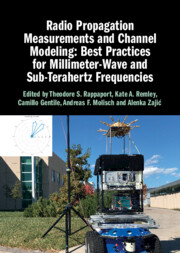Book contents
- Frontmatter
- Dedication
- Contents
- Contributors
- Preface
- 1 Introduction
- 2 Estimating Channel Characteristics from Measurements
- 3 Channel Sounders
- 4 Verification Techniques
- 5 Introduction to Millimeter-Wave Channel Modeling
- 6 Path Loss/Shadowing
- 7 Multipath Component Clustering
- 8 Dispersion Characteristics
- 9 Peer-to-Peer Networking
- 10 Temporal Variance: Literature Review on Human Blockage Models
- 11 Terahertz Channels
- 12 Connection between the Measurements and Models
- 13 Conclusions
- Index
7 - Multipath Component Clustering
Published online by Cambridge University Press: 18 August 2022
- Frontmatter
- Dedication
- Contents
- Contributors
- Preface
- 1 Introduction
- 2 Estimating Channel Characteristics from Measurements
- 3 Channel Sounders
- 4 Verification Techniques
- 5 Introduction to Millimeter-Wave Channel Modeling
- 6 Path Loss/Shadowing
- 7 Multipath Component Clustering
- 8 Dispersion Characteristics
- 9 Peer-to-Peer Networking
- 10 Temporal Variance: Literature Review on Human Blockage Models
- 11 Terahertz Channels
- 12 Connection between the Measurements and Models
- 13 Conclusions
- Index
Summary
In this chapter we present introductions and some recent progress of clustering and tracking algorithm designs for use in radio channels, which have been widely used in cluster-based channel modeling for 4G and 5G communications.
Keywords
- Type
- Chapter
- Information
- Radio Propagation Measurements and Channel Modeling: Best Practices for Millimeter-Wave and Sub-Terahertz Frequencies , pp. 122 - 152Publisher: Cambridge University PressPrint publication year: 2022
- 1
- Cited by

